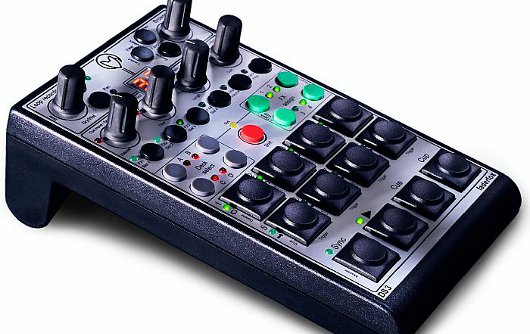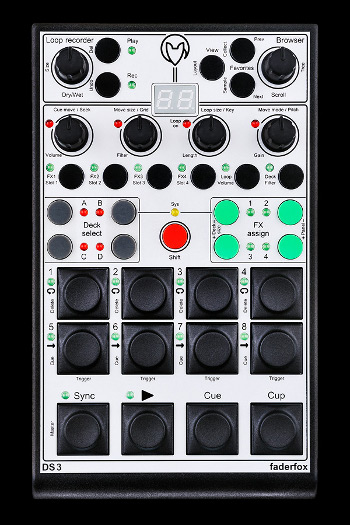Faderfox Micromodul DS3 Controller review
The Micromodul DS3 controller provides hands-on control for your DJ software of choice. Shipping with the means to get you started straight away on Traktor, there are no drivers in sight as Faderfox have made it class compliant. It can be fired up simply by plugging in via USB to Mac or PC. The controller is slight, 180mm x 105mm x 70 mm in size and weighs in at a featherweight 350gs, meaning this small but tactile control unit will be flying with your hand luggage while providing you with the means to deliver your set efficiently and confidently.
The tough black plastic casing houses six push encoder knobs and 20 function buttons, along with 12 larger controls for cueing, syncing and getting to grips with basic playback of your chosen DJ software. Set into the metal face plate is a two digit display which provides feedback (either numerically or with simple alphabetical initials) to let you know exactly where you are. Billed as the successor to Faderfox’s previous DL3 and DX3, the unit’s simple layout helps you, the DJ, gain access for “in the moment” control of effects, loops and cue points for up to four decks in your sets.
In the top right hand corner are three small buttons and a push encoder dedicated to various browsing functions, which allow you to gain different views of your chosen set up. There is a shift key, which, when held down, improves the accessibility of your music. Next to it on the left is the “Loop recorder” control. If you’re familiar with Traktor then you’ll be aware of its ability to record loops and assign them to one of the available sample slots. All of this can be done from the DS3 by using one encoder knob and two buttons to record and playback. It’s also possible to assign the sample loop to a hot key without having to look at your computer screen.
Below are four encoders and six buttons which help you manipulate everything from effects parameters to loop sizes and volumes. This section gives you the control to browse through your music once you’ve assigned it to one of the decks, which you can utilise by clicking the dedicated deck select buttons below. Next to this on the right are the effects buttons, with the useful shift key sitting in between. You’ll find the eight sturdy hot cue buttons under them, with four similar transport buttons at the bottom. All the encoders have a satisfying click when you push them, and the step rotary motion gives you a good feel for where you are and safeguards against accidental slips.
After plugging the controller into a USB port on your Mac or PC, the unit will switch on and, as it is class compliant, there are no drivers to install. The included CD allows you to connect to your software. If you are using Traktor, a few quick changes in the preferences section can get you up and running relatively quickly. The interaction between the controller and software is smooth and there are no delays, lags or glitches. Browsing and assigning music to one of the decks is done by the touch of a button and the turn and push of one encoder, and all transport and hot cue features are simple and intuitive. Looping can be done on the fly with the push of one encoder; turning it will change the loop length and access to effects of Traktor is equally quick. Applying effects by using the dedicated green keys and turning them on with the push of an encoder, again, is straight forward. You can browse through the different effects available by holding down the shift key and scrolling using one of the knobs. The DS3 encourages your creativity here by giving you direct control over effects parameters by manipulating the four encoders above the deck assign and effects assign keys.
The advanced Traktor user can engage with the more challenging functions of the software. If you want to loop one of your tracks and load that loop onto one of your hot keys, it can be done by holding down the button for the deck that is looping, and while depressed, hitting one of the top four hot key buttons. You can also make use of the sample slots in Traktor by putting the controller into its sample deck mode, allowing you to browse and assign any of your favourite loops or one shots; again this is triggered by using one of the hot buttons. It’s also possible to make use of Traktor’s loop record function – separate to the basic loop function – and assign it to a sample slot without having to stare at your computer screen.
The DS3 is noticeably small and a lot of attention to detail has gone into making it a complete package. No function has been left out and it’s possible to have complete access to Traktor from the one box. The one drawback to putting all this functionality into such a small package is that a steep learning curve awaits; you need to familiarise yourself with a lot of different routines and combinations to become adept at realising your creativity. To help new users get to grips with the DS3, Faderfox have posted a couple of tutorials on their website and this will undoubtedly help inexperienced users. It means that, firstly, a huge instruction booklet isn’t necessary and, secondly, you can actually see the controller in action.
The DS3’s robust, satisfying build ensures it will be used with confidence in a variety of different settings. As a MIDI controller powered through USB, you can assign any of its buttons to any function the mapping of your software allows. Essentially, Faderfox have provided a versatile and stable way of interfacing with your software and at the same time offer an alternative means of freeing you from your computer during a set.
Specifications:
| System Requirements | Mac or PC, USB 1.0 |
| Dimensions | 180mm x 105mm x 70 mm. |
| Weight | 350 grams |
| Power | Power via USB 1.0, 500mW/100mA bus power |
| Features | 6 assignable rotary knobs, 20 assignable function buttons, 12 durable transport and cue buttons, 31 LEDs, a 2-digit display |
| Data | CD with instructions and Unix .tsi setting files. |

